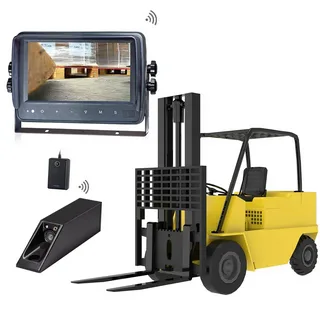Forklifts are essential machines in warehouses, factories, and other industrial settings, enabling the efficient transport of heavy loads. However, their operation often comes with inherent risks due to limited visibility, leading to accidents, injuries, and damage to property. One of the most effective ways to reduce these risks and enhance safety is by incorporating forklift cameras.
Forklift cameras offer operators a clearer, more comprehensive view of their surroundings, helping to eliminate blind spots and improve situational awareness. These cameras provide real-time video feeds to operators, ensuring a safer working environment. In this post, we’ll explore how to use forklift cameras to enhance safety in industrial settings.
The Importance of Forklift Cameras
Forklifts typically have several blind spots, particularly in the front and rear, making it difficult for operators to see pedestrians, other machinery, or obstacles nearby. Accidents involving forklifts often occur because operators fail to notice these hazards, whether it’s a worker walking through an aisle or another vehicle approaching from behind.
By installing forklift cameras, operators can gain a clearer view of the environment, reducing the risk of these accidents. Cameras mounted on different parts of the forklift offer operators a 360-degree view, allowing them to spot obstacles in real-time. This visibility not only helps prevent collisions but also promotes safer operation of forklifts.
Key Benefits of Forklift Cameras
- Eliminate Blind Spots: Forklift cameras eliminate blind spots by offering clear visibility around the forklift, such as a rearview camera to help operators avoid backing into obstacles or vehicles.
- Improve Pedestrian Safety: With forklift cameras, operators can spot pedestrians in time to stop or slow down, significantly reducing the risk of accidents in busy warehouse environments.
- Enhance Maneuvering and Positioning: Forklift cameras improve maneuvering in tight spaces, allowing operators to navigate narrow aisles and position loads accurately, enhancing both safety and efficiency.
- Monitor Surrounding Conditions: Forklift cameras provide a constant view of the surroundings, helping operators identify hazards like spills or obstacles, allowing them to act before accidents occur.
- 24/7 Video Recording: Many forklift cameras feature video recording, enabling continuous footage to review incidents or assist in training by providing real-life examples of forklift operation.
Types of Forklift Cameras and Their Applications
There are various types of forklift cameras tailored to different needs within industrial environments. Here are some common configurations:
A. 360-Degree Cameras: Forklift cameras with 360-degree coverage provide a full view of the forklift’s surroundings, helping operators monitor large spaces and avoid accidents.
- Rearview Cameras: Forklift cameras installed at the back enhance visibility while reversing, preventing accidents in areas with limited sightlines.
- Side-Mounted Cameras: Forklift cameras on the sides allow operators to monitor narrow aisles and detect obstacles, improving safety in tight spaces.
- Infrared Cameras: Forklift cameras with infrared technology illuminate low-light environments, ensuring clear visibility even in poorly lit areas.
Best Practices for Using Forklift Cameras
To maximize the effectiveness of forklift cameras, it’s important to follow certain best practices:
- Proper Camera Placement: Forklift cameras should be strategically placed to cover all critical areas, ensuring full visibility of blind spots based on the forklift’s design and warehouse layout.
- Regular Maintenance: Forklift cameras require regular maintenance, including lens cleaning and system checks, to ensure clear, reliable visibility and optimal safety.
- Training Operators: Operators must be trained to use forklift cameras effectively and interpret the video feeds to make informed safety decisions.
- Integrating with Other Safety Systems: Forklift cameras should be combined with features like proximity sensors and alarms to create a multi-layered safety system for added protection.
Conclusion
Forklift cameras are essential for safety in industrial settings, offering benefits like eliminating blind spots, improving pedestrian safety, and enhancing maneuverability. These cameras provide real-time video feeds, helping reduce accidents and increase overall safety.
Integrating forklift cameras into the workplace enhances safety and boosts productivity by allowing operators to work more efficiently. Investing in these systems helps prevent accidents, ensuring a safer and more productive environment.
If you want to enhance safety and visibility in your workplace, consider installing forklift cameras today.

Be the first to comment on "How to Use Forklift Cameras for Enhanced Safety"